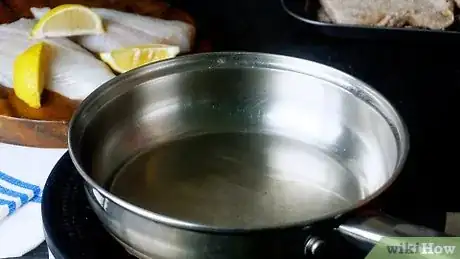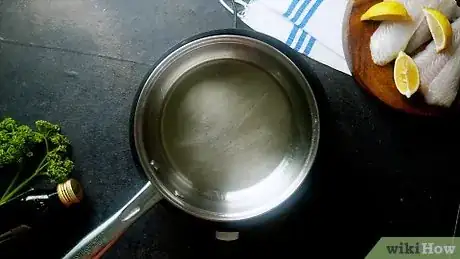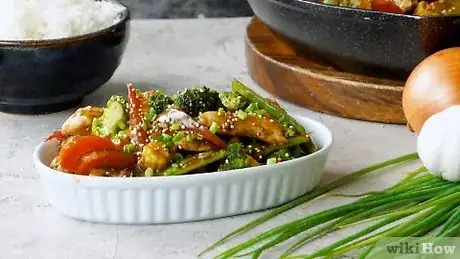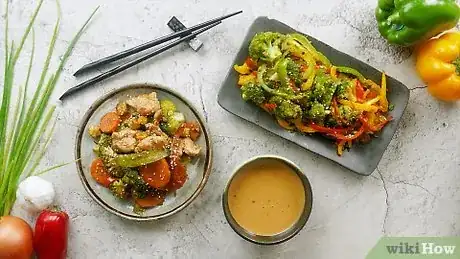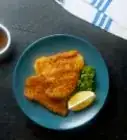This article was co-authored by wikiHow Staff. Our trained team of editors and researchers validate articles for accuracy and comprehensiveness. wikiHow's Content Management Team carefully monitors the work from our editorial staff to ensure that each article is backed by trusted research and meets our high quality standards.
There are 16 references cited in this article, which can be found at the bottom of the page.
The wikiHow Culinary Team also followed the article's instructions and verified that they work.
This article has been viewed 143,182 times.
Learn more...
Pan-frying is an easy method of cooking food by heating oil in a heavy skillet. You can pan fry just about anything, including vegetables, meat, and fish. There are a few methods of pan frying. The basic pan fry uses medium heat and a little bit of oil to cook whole pieces of meat and un-chopped vegetables. Shallow frying uses more oil to fry battered foods, such as fried chicken or eggplant parmesan. Stir-frying uses high heat and a little oil to cook chopped vegetables and meats. Once you've got the method down, you'll have to write down a list of everything you want to try!
Steps
Making a Basic Fry
-
1Take out a heavy skillet. You can also use a sauté pan or frying pan. You want to choose a pan that has a flat bottom with high edges that are either sloped or straight. Be sure that it is wide enough for what you are cooking, as you will not want to overcrowd the pan.[1]
-
2Heat the pan on medium-high. Unless you have a non-stick pan, you should heat the pan before you add the oil. This will prevent the meats from sticking to the pan. It will also heat the oil more quickly. It will only take two or three minutes for the pan to heat up.[2]
- If you have a nonstick pan, add the oil to a cold pan and heat both up together.
Advertisement -
3Add cooking oil. One or two tablespoons is enough. Tilt the pan to evenly spread the oil over the surface. The best oils to use are flavorless. These include light or refined olive oil, canola oil, and peanut oil.[3] Avoid using extra-virgin olive oil (EVOO) if possible.
- EVOO can burn in the pan when frying because of its lower smoke point. EVOO starts to smoke at 325-375F compared to 465F for light or refined olive oil.[4] Since food starts to fry around 365-375F, your extra-virgin olive oil may begin to burn before it starts to fry, giving your food a bitter taste.[5] If you have no other option, watch the oil carefully. If it starts to smoke, remove from the heat and let it cool before dumping it and trying again.
-
4Wait for your oil to heat. If you added the oil to a hot pan, it should heat up quickly—within a minute of adding it. If you added oil to a cold pan, it may take a few minutes for it to heat up. There are a few tests you can do to see if it is hot enough.
- Use a cooking thermometer to know the exact heat. Stick the metal end into the oil, and wait 5 seconds for an accurate reading. The oil should be hot enough around 365 degrees F.
- Stick the handle of a wooden spoon in it. Bubbles will rise and pop when it is hot.[6]
- If you don't have a wooden spoon, try a drop of water instead (and no more than a drop). The water will begin to sizzle and pop when the oil is hot enough. This may cause the oil to splatter so be careful.
- Do not leave your pan unattended while heating it at the stove. It only takes a few minutes for it to heat up, and you do not want to burn the oil or start a fire.
-
5Add your ingredients to the hot oil. Make sure that every piece has plenty of room. No two pieces of meat should be touching. Leave a small space between each. If you are cooking vegetables, make sure that there is a single layer of veggies; they should not be piled on one another. Food releases steam as it is fried. If you overcrowd the pan, the steam will not release, and you may end up with a soggy meal.[7]
- Understand that whatever side goes down first will look the best so if you are aiming for a nice presentation, put your chicken breasts down on the rounded side and your fish flesh side down instead of skin side.[8]
-
6Flip the meat halfway through. If possible, use tongs instead of a fork. A fork can puncture the meat and lose its juices. Different meats take different lengths of time. You will have to time yours based on the size of each cut and the type of meat. Flipping the meat too often or too soon can ruin the batter.
-
7Cook to your desired doneness. You may want to use a thermometer to make sure that the meat is fully cooked through. Stick the thermometer in the thickest part of the meat. Otherwise, you can cut open the meat to see if it is done or not. Different types of meats require different temperatures for safe eating.
- Beef steaks need an internal temperature of 145 degrees F. The inside can be pink, but not red.
- Chicken and turkey need internal temperatures of 165 degrees F. The inside should be white, not pink. Juices should run clear.
- Pork should have an internal temperature of 145 degrees F. The inside should be mostly cooked white or brown, although there may be a slight pink tint.
- Fish should have an internal temperature of 145 degrees F. The flesh should flake away easily with a fork.[13]
-
8Remove from pan. Use tongs if possible. A spatula is a good back up. Place the food on a plate. If you are frying meats such as pork or beef, you may want to let the meat rest for three minutes to keep its juices intact and to let it finish cooking.[14] Serve immediately.
Shallow-Frying
-
1Add an inch of cooking oil to a skillet. The oil should come halfway up the sides of the pan. Canola, vegetable, sunflower, and light olive oil work well for this type of frying.
-
2Batter the food before frying. Have the battered food ready for when the oil is hot. You can check if the oil is hot enough by sticking a wooden spoon into the oil. The oil will bubble around the spoon when it is ready.
-
3Add your food to the hot oil. Make sure that every piece has plenty of room. You do not want to crowd the food, or it will not fry properly. The food should sizzle as it touches the oil.[15] If it does not, the oil is not hot enough. Wait to add the other pieces.
-
4Flip halfway through. Use tongs if possible. Forks can be used to flip, but they are not ideal. You only want to flip once to ensure that the batter cooks correctly. Flipping too often or too soon can cause the batter to fall off.[16]
-
5Transfer to a paper towel. Once you have removed your food, place them on a paper towel. You can use tongs or a slotted spatula. The paper towel will soak up excess oil, giving you a crispier batter.[17] The meats should rest for a moment to finish cooking. Serve immediately.
Stir-Frying
-
1Choose a wok. A wok is large pan with sloped sides. Woks are ideal for this type of frying because you can cook in stages. While you can use a skillet for stir-frying, the results will not be as consistent or as tasty.[18]
-
2Cut up your meats and vegetables. Stir-frying is similar to sautéing in that it requires you to cut up your foods before you cook them. Make sure that all pieces are roughly the same size and weight. This will ensure uniform cooking. Have them all chopped and ready before you heat the pan. [19]
-
3Heat up one to two tablespoons of oil. Set the stove to high heat. Stir-frying requires higher heat than other types of pan frying. Peanut oil is best for stir-frying, although you can use canola or vegetable oil.
-
4Add your ingredients. Sear the meat first by adding it to the pan and flipping it after a minute until both sides are browned. Then add your vegetables. Some vegetables-- such as broccoli, baby corn, and carrots-- take longer than others and should be added first. Add in soft vegetables like bok choy or mushrooms at the end.[20]
-
5Toss ingredients in the wok. Use a wooden spoon to mix, flip, and stir the ingredients. You want to make sure that everything cooks evenly. If something looks like it is over-cooking, push it up against the cooler sides of the wok so that it does not burn.
-
6Pour sauce into the pan. Let the sauce steam and cook into the vegetables. Stir well to make sure that everything is coated. There are many types of popular sauce that you can either make or buy, such as:
- Soy sauce
- Soy ginger sauce
- Orange sauce
- Hoisin sauce
- Black bean sauce
-
7Scoop out of the pan to serve. You can serve it on rice, noodles, or on its own. Eat it while it is hot, or cool and save for later. Stir-fry keeps well if stored in the refrigerator. You can reheat it later in the microwave or eat it cold.
-
8Finished.
Warnings
- Do not add water, cover, or overcrowd the pan.⧼thumbs_response⧽
- Do not overheat oil. If the oil is smoking, it is too hot.⧼thumbs_response⧽
Things You'll Need
- Heavy skillet
- Wok
- Cooking oil (olive oil or canola oil is best)
- Meat or vegetable
- Stove
References
- ↑ http://www.cookinglight.com/cooking-101/techniques/cooking-class-pan-frying
- ↑ http://www.scienceofcooking.com/why_food_sticks.htm
- ↑ http://www.cookinglight.com/cooking-101/techniques/cooking-class-pan-frying
- ↑ http://www.seriouseats.com/2014/05/cooking-fats-101-whats-a-smoke-point-and-why-does-it-matter.html
- ↑ http://www.bhg.com/recipes/how-to/cooking-techniques/frying-basics/
- ↑ http://noshon.it/tips/4-ways-to-test-if-your-oil-is-hot-enough-for-frying/
- ↑ http://www.cookinglight.com/cooking-101/techniques/cooking-questions-tips/overcrowding-pan-cooking
- ↑ http://www.cookinglight.com/cooking-101/techniques/cooking-class-pan-frying
- ↑ http://www.bhg.com/recipes/chicken/breasts/how-to-cook-boneless-chicken-breasts/#page=0
- ↑ http://www.bbcgoodfood.com/howto/guide/how-cook-perfect-steak
- ↑ http://www.bbcgoodfood.com/howto/guide/how-cook-perfect-steak
- ↑ http://www.bhg.com/recipes/how-to/cooking-basics/how-to-fry-pork-chops/#page=0
- ↑ https://www.foodsafety.gov/keep/charts/mintemp.html
- ↑ https://www.foodsafety.gov/keep/charts/mintemp.html
- ↑ https://www.thekitchn.com/quick-tip-how-to-tell-when-oil-53815
- ↑ http://www.cookinglight.com/cooking-101/techniques/cooking-class-pan-frying
- ↑ http://www.marthastewart.com/268805/cooking-school-how-to-fry
- ↑ http://www.bhg.com/recipes/how-to/cooking-basics/how-to-stir-fry/#page=0
- ↑ http://www.seriouseats.com/2010/06/wok-skills-101-stir-frying-basics.html
- ↑ http://www.bbcgoodfood.com/videos/techniques/how-make-stir-fry
About This Article
To pan fry something, start by heating a skillet or pan with high edges over medium-high heat for a few minutes. Then, add 1-2 tablespoons of cooking oil, like olive or vegetable oil, and wait for it to heat up until it sizzles and pops when you drop water into it. Next, add the food you want to fry to the pan in a single layer so that nothing is touching. Finally, fry the food until it's cooked through, flipping it over halfway through so both sides are brown and crispy. To learn how to stir-fry, scroll down!
